Looking Back at Texas Football’s Biggest Moments in the Big 12
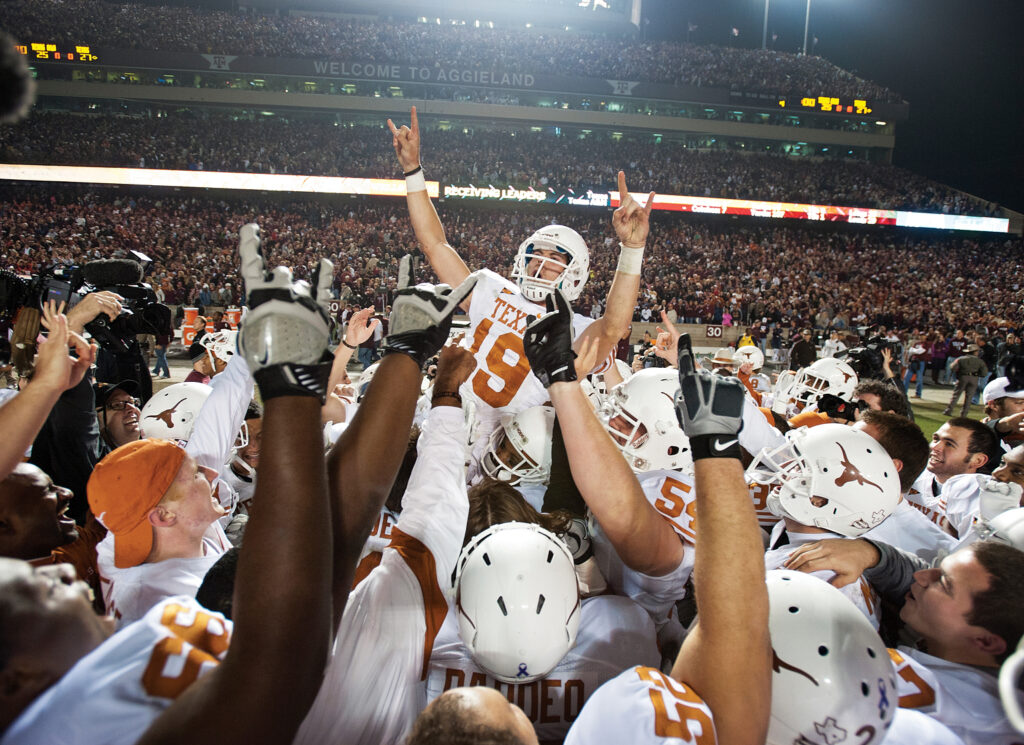
“S-E-C! S-E-C!”
It’s a chant that actually dates back to the Arkansas-Texas rivalry at the end of the Southwest Conference (SWC), with fans of both teams using the acronym to taunt the other as the Razorbacks prepared to leave the SWC for the Southeastern Conference in 1991. Five years later, the SWC itself was no more, as Texas joined up with Texas A&M, Texas Tech, Baylor, and the Big 8 schools to form the new Big 12.
By the 2000s, fans of every SEC school shouted it ad infinitum at their unamused non-conference opponents, as the SEC began a streak of seven straight national championships from 2006 to 2012. During that period, of course, Texas and Texas A&M supporters also reprised the chant when the Aggies left the Big 12 for the SEC in 2011.
All of that is history now. After this season, the Big 12 as we know it is no more, with Texas and Oklahoma joining the Razorbacks and Aggies—as well as the likes of Alabama, Georgia, and LSU—in the country’s dominant college football conference. The move will come alongside an expanded 12-team College Football Playoff format that is expected to feature more SEC and Big 10 teams than any other conference.
For the final time, Texas will play Baylor, TCU (which only joined the Big 12 after A&M left), Kansas, Iowa State, Kansas State, and Texas Tech as conference rivals—as well as the University of Houston as a conference rival for the first and only time since the end of the SWC. As we look back on the program’s highs and lows from the era, here’s the funny part: Not many of the highlights involve the teams they are about to leave behind. Because while UT may have only won three conference championships as a member of the Big 12, the team’s exploits still primarily played out on the national stage. And that is not about to change.
Dec. 7, 1996: Inaugural Big 12 Champion
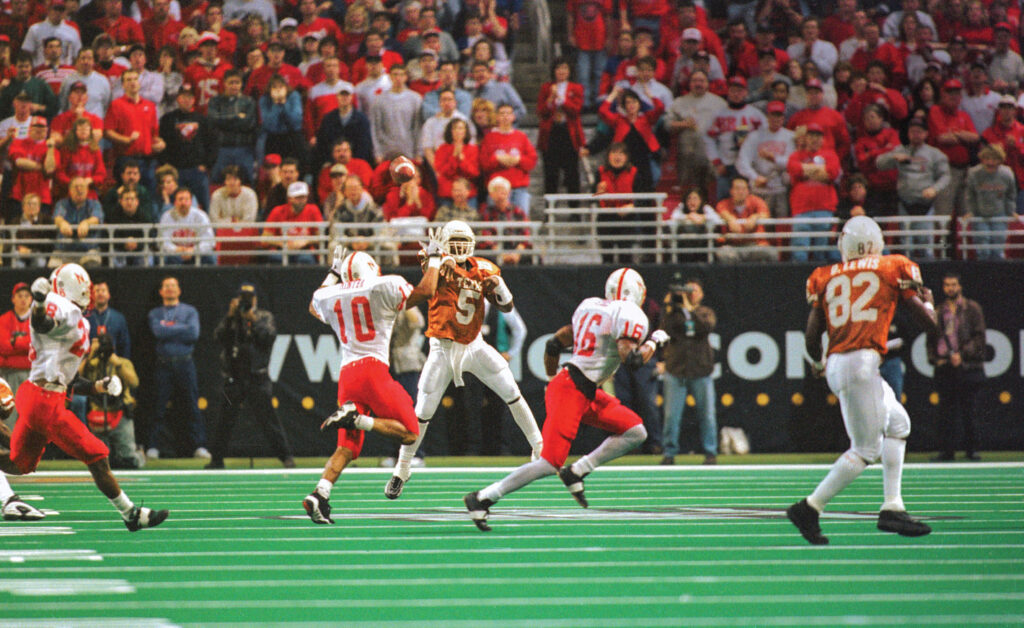
Despite being the biggest kid on the block in the newly formed Big 12, the Longhorns did not exactly take it by storm. They’d left the SWC as 10-win champions in John Mackovic’s fourth season as head coach, but they started his fifth season in 1996 with a 2-2 record in non-conference play (losing to Notre Dame and Virginia) and a 3-4 record overall (with October losses to a lousy Oklahoma team and No. 8-ranked Colorado).
They finished the year strong with four straight wins, including a 51-15 branding of Texas A&M. Then with the realignment came a new wrinkle: the neutral-site, TV cash-cow, conference championship game, which under NCAA rules could only happen with at least 12 teams in a league (the SEC started playing one in 1992, having added South Carolina and Arkansas to reach the magic number).
Because these new and expanded conferences were split into divisions, Colorado got left at home, despite sitting at 9-2 overall. Instead, Big 12 North champion Nebraska would play host to, that’s right, the Big 12 South champion University of Texas Longhorns, who came in at 7-4.
So quarterback James Brown led the Longhorns into St. Louis’ Trans World Dome—a “neutral” location that did them no favors—as a three-touchdown underdog to what was then one of the most imposing programs in the land. The Huskers had won national championships in 1994 and 1995 and merely had to dispatch the Big 12’s fourth-best team (Kansas State also had a better record than Texas) to face Florida State in the Sugar Bowl and earn a third title.
You know what happened next. The Horns made a game of it from the start, with QB Brown, running back Priest Holmes, and wide receivers Mike Adams and Wane McGarity all putting up big numbers. Nebraska took a 27-23 lead with just over 10 minutes left in the fourth quarter, which the Horns immediately answered with a 66-yard McGarity TD catch. After a stalled drive, Huskers punter Jesse Kosch pinned UT at their own 7-yard line in the final minutes.
The Horns picked up one first down, but soon faced fourth-and-inches at their own 28. Mackovic elected to go for it. To really go for it. With everyone expecting either a quarterback sneak or Priest Holmes dive, Brown rolled out to his left and lofted the football to tight end Derek Lewis, who was so wide open behind the Huskers’ short-yardage defense that he took it 61 yards to the 11, where Holmes finished off the stunned Cornhuskers with an 11-yard touchdown run for a 37-27 final score.
“To hell with Nebraska. We got the heart,” Adams exulted in an account of the game by Sports Illustrated’s Tim Layden. Added offensive tackle Octavious Bishop, “Nobody gave us a chance. We shocked the world.”
Sept. 13, 1997: Rout 66
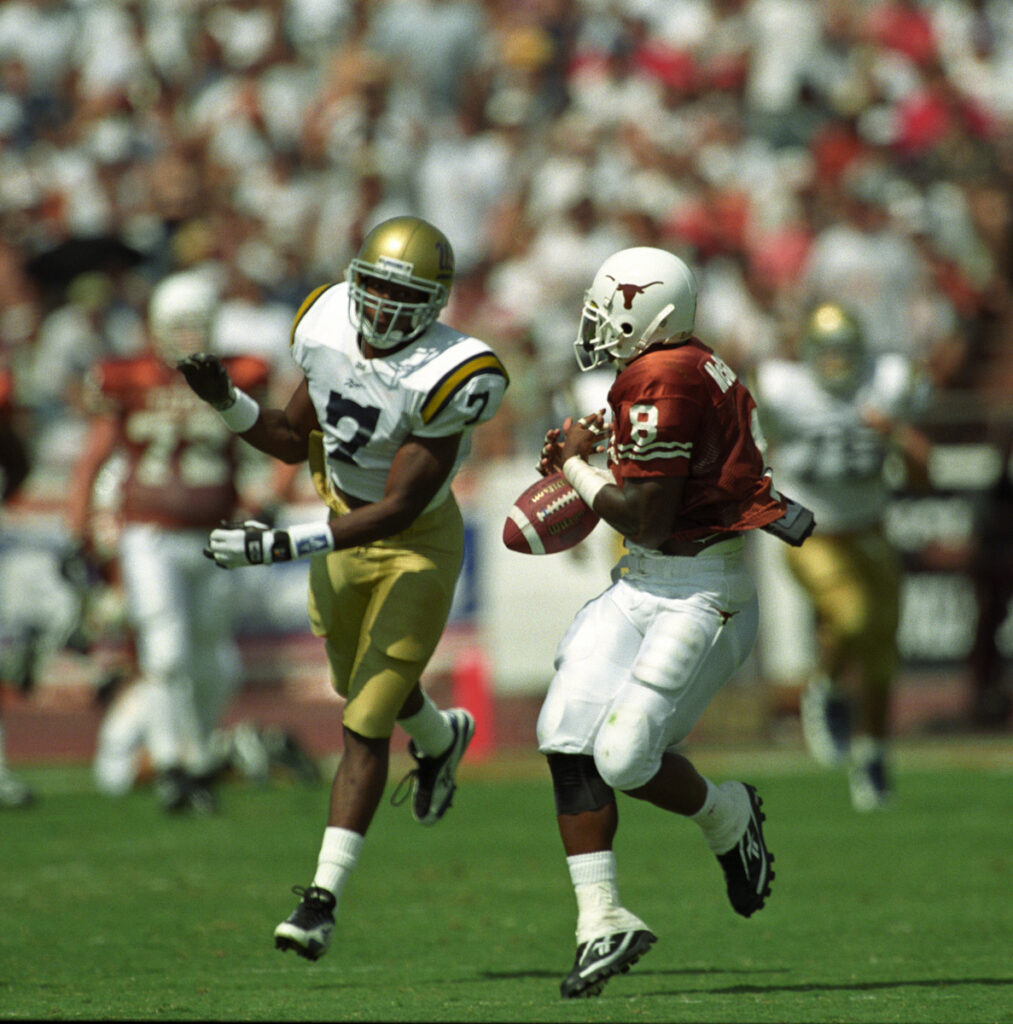
No, you couldn’t call this one a highlight. But not even the formation of the Big 12 itself was as historically significant a moment for Texas football as this one. At 66-3, the visiting UCLA Bruins delivered the Longhorns’ worst loss since a 68-0 defeat at the hands of the University of Chicago (which stopped playing Division I football in 1939)—and worst home loss ever—telegraphing the end of the Mackovic era.
Yes, the former Kansas City Chiefs and University of Illinois coach had just won three straight conference championships in two different conferences, but his Horns had also ended each of the last two seasons with bowl game losses on the national stage. Like David McWilliams and Fred Akers before him, Mackovic just wasn’t Darrell K Royal, and any illusion that he’d be the coach to bring a national championship back to Austin faded on this day … and then was completely incinerated over the remainder of a 4-7 season.
But that also meant Mack Brown was on the way.
Nov. 27, 1998: Run, Ricky, Run!
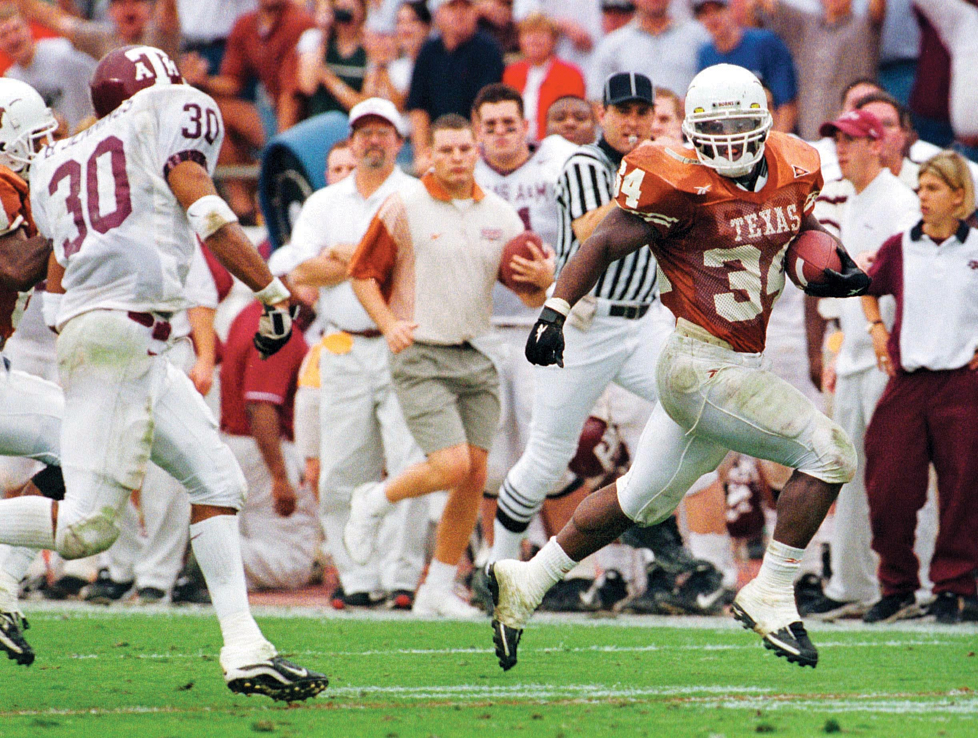
In spite of its losing record and fired coach, the 1997 team still had a star in Ricky Williams. The junior running back and two-sport athlete (in the Philadelphia Phillies farm system) had already rushed for 990 yards as a freshman in 1995 and 1,272 yards as a sophomore in ’96. In ’97, he carried the ball 279 times for 1,893 yards and won the Doak Walker Award as the nation’s finest running back. He was ready for the NFL. But Brown won him over.
“We have just had a successful recruiting class,” Brown joked when Williams announced he’d be returning for his senior season instead of entering the draft.
It was also a season in which a scrawny-looking freshman quarterback by the name of Major Applewhite led the Horns to a 9-3 record, including a 34-3 win over OU and another upset of Nebraska. Most of all, however, there was the Texas A&M game. By the time the unranked Longhorns took on on defensive star Dat Nguyen and the No. 6-ranked Aggies, Williams had already rushed for 1,870 yards on the season, including two 300-yard games, and needed only 63 to become the NCAA’s career leading rusher, passing Tony Dorsett’s mark of 6,082. He took care of that before the first quarter was over, breaking the record on a 60-yard TD run, and finished with 259 in the game and 6,279 in his career.
Oh yeah, and the Horns took down the Aggies 26-24 on a Kris Stockton field goal with five seconds remaining, capping off an 11-play, 70-yard drive in which Applewhite completed seven of eight passes. A few weeks later, Ricky joined Earl Campbell as UT’s only Heisman Trophy winners.
Jan. 1, 2005: The Granddaddy
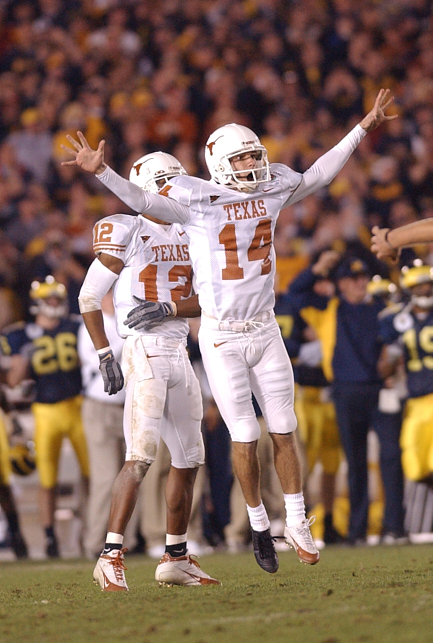
Was it as good as the next year’s Rose Bowl? No. But the Longhorns’ first-ever appearance in the storied Pasadena game (which had been exclusively the domain of Big 10 and Pac 12 teams for most of its history) was the result of a masterful lobbying job by Brown that saw UT sneak past a higher-ranked Cal team for the last spot in one of the four Bowl Championship Series (BCS) games, where their opponent would be Michigan.
And what a game it was, with two talented, offensively explosive teams trading highlight-reel blows until the final seconds. The Wolverines were led by quarterback Chad Henne and dynamic receivers Braylon Edwards and Steve Breaston, who set a Rose Bowl record with several explosive kick returns. But in the end, Longhorns QB Vince Young was sensational, rushing for more yards (192) and touchdowns (four, including a 60-yard dash to break open a 14-14 tie early in the second half) than he threw (180 and one). The back-and-forth battle came down to a Dusty Mangum field goal as time expired: 38-37 Texas.
“There will never be a better game in the Rose Bowl,” Brown said afterward. He could not have been more wrong.
Jan. 4, 2006: VY Finishes the Job

If you’re reading this and weren’t there in person, you know exactly where you were when this game ended. And you remember every moment. Pete Carroll’s Southern Cal team was the current college football juggernaut: two-time defending national champion (one of them split with LSU), led by quarterback and 2004 Heisman winner Matt Leinart and running back Reggie Bush, who’d been named the 2005 winner weeks before the game. Their assistant head coach, a former Brigham Young quarterback by the name of Steve Sarkisian, was also someone to watch.
Bush, of course, would later be forced to surrender the trophy due to that old pre-NIL bugaboo of “violating NCAA rules” regarding extra benefits. To Texas fans, he shouldn’t have even won it in the first place. That’s because Vince Young had come in second place, capping off a season in which he would become UT’s all-time leader in both career and single-season total yardage. If voting for the Heisman didn’t happen until after the bowl games and national championship were decided, things may have turned out differently.
The Horns had finally won another conference title, dislodging Bob Stoops’ Oklahoma team as the Big 12’s national power, and the 11-0 season was Brown’s fifth straight with double-digit wins. While VY understandably got most of the attention—he was the best player in the country, after all—this was also a talented and physical defensive team, with a star-studded secondary (Michael Huff, Aaron Ross, Cedric Griffin) as well as defensive end and national defensive Freshman of the Year Brian Orakpo.
All that was missing was the national championship, which finally came when Young almost single-handedly carried the Horns back from a 38-26 fourth-quarter deficit. After Texas held the Trojans on fourth down with just over two minutes left, the Longhorns still trailed 38-33. But there was never any doubt … even when it was fourth-and-5 at the 8-yard line with 19 seconds left. Touchdown, Vince—and then he ran for the two-point conversation to make it 41-38.
Some have called it the best national championship game in college football history, if not the best college football game ever played … and that’s not viewing it through burnt-orange glasses, either.
Nov. 1, 2008: Wrecked
In college football, if you have a quarterback, you have a chance. And in Colt McCoy, the Longhorns almost immediately had a QB to replace VY. UT’s shot at repeating in 2006 fell apart when the then-freshman got injured in a November game against Kansas State. After finishing with a 10-3 record in both 2006 and 2007, the Horns weren’t expected to win it all in McCoy’s junior year. But they should have had the chance. Texas was ranked fifth in the country when they upset No. 1 Oklahoma in the Red River Rivalry game, elevating them all the way to the top spot. Until they traveled to Lubbock to face No. 6-ranked Texas Tech on Nov. 1.
This was, perhaps, as good a game as either of the Longhorns’ Rose Bowls, save for the result. It was Texas Tech’s Graham Harrell and Michael Crabtree who made the last big play in yet another “last team with the ball wins” shootout. Texas led 33-32, when Crabtree made a balletic sideline catch that turned into a 28-yard touchdown with one second left in the game for a 39-33 Red Raiders win.
The loss did not put the Longhorns out of the national championship conversation, as Oklahoma then defeated Texas Tech. That meant a three-way tie for the Big 12 South championship and a dogfight in the BCS standings, since that turned out to be the fifth—and decisive—tiebreaker for said championship. Unfortunately, the BCS, with its hodgepodge of polls and computer rankings, had Oklahoma ranked ahead of Texas. UT was robbed, but the quirks and flaws of that format and the sport’s ever-changing criteria would continue to resonate into the College Football Playoff era.
Jan. 7, 2010: Hello, Saban
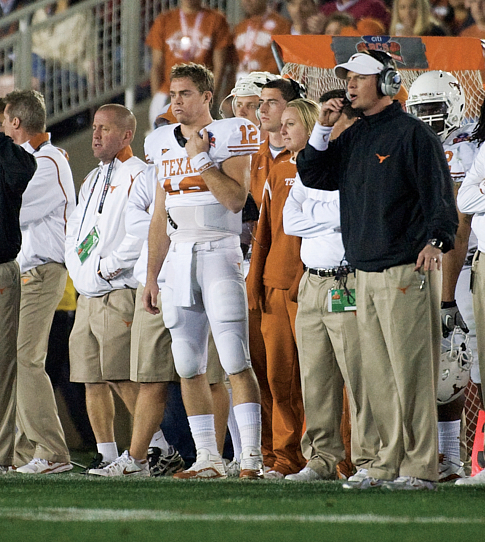
The alternate reality we still prefer: McCoy does not get hurt in the first quarter of this game, UT wins its fifth national championship, and Brown is still on the sideline at DKR-Texas Memorial today (just kidding about that last one, though it’s probably just as well coach-in-waiting Will Muschamp never ascended either).
In another alternate reality, freshman backup Garrett Gilbert plays just a little better (i.e. he doesn’t throw that shovel pass), or Alabama plays just a little worse.
In the real world, this was an epochal moment for all the wrong reasons: the game where Alabama became Alabama and Nick Saban became Nick Saban, sparking a dominance that hasn’t at all ended—even separately from Bama’s five national championships following this game. Saban has loomed over not just the entire sport, but UT’s own head coaching position—whether because he himself was rumored to be a candidate for it back when Brown still had the job, or because the Longhorns finally hired someone off of Saban’s coaching tree in his former assistant and offensive coordinator Sarkisian.
Nov. 4, 2011: Goodbye to Texas A&M University

It’s not like the Texas-Texas A&M rivalry needed extra juice, but with both sides fighting over the details of A&M’s departure to the SEC and insisting that it was the other team that didn’t want to play them out of conference, what was ostensibly the final matchup after well over 100 years (UT’s record: 76-37-5) just, well, meant more. With Texas’ record at 6-4 and A&M’s at 6-5, this was the biggest game either team would play that season—though it’s always a big game—with fans on both sides hoping to deliver a big Nelson Muntz-like ha-ha! as the Aggies took their leave.
At home on Thanksgiving night, A&M ran out to an early 10-0 lead and held on 16-7 at the half (with the sole Texas touchdown coming on a trick-play pass by wide receiver Jaxon Shipley). But UT won the second half, intercepting A&M quarterback Ryan Tannehill three times (one for a touchdown by Carrington Byndom and one each by Kenny Vaccaro and Quandre Diggs). UT led 24-16 at the end of the third quarter, but A&M counter-punched with a touchdown and a field goal in the fourth to make it 25-24 Aggies with 1:48 left. Longhorns QB Case McCoy—Colt’s younger brother, who’d been benched in favor of David Ash earlier in the season—seized the moment. Helped by a personal foul penalty against A&M, he followed three straight completions with a 25-yard run. With three seconds remaining, future NFL great Justin Tucker nailed a 40-yard field goal to earn bragging rights forever—or 13 years, as it turns out.
And now that the years of pretending not to care about each other are finally over, let’s admit it: Yeah, we missed you, “little brother.” You too, Reveille.
And Goodbye to All the Rest
Yes, we’re stopping here. A symbolic choice, but also, with apologies to Sam Ehlinger (“we’re back” became another punchline, but that was still a great season) and Bijan Robinson (see you in the NFL), the Charlie Strong and Tom Herman years just can’t compete with all that came before. Although our time in the Big 12 may be a mere blip compared to 82 years of Southwest Conference history and whatever lies ahead, we’ll always have 2005 … and the best moments of the Sarkisian years are surely yet to come.
CREDITS: Texas Athletics



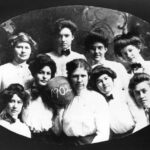









No comments
Be the first one to leave a comment.